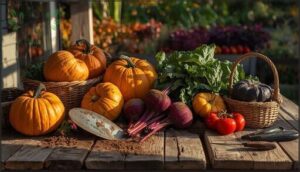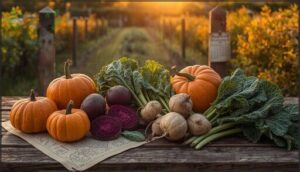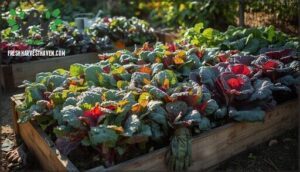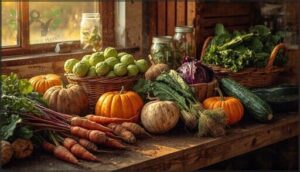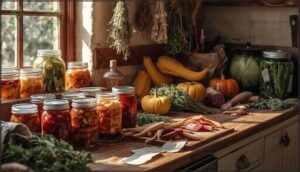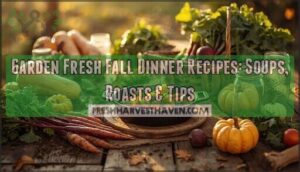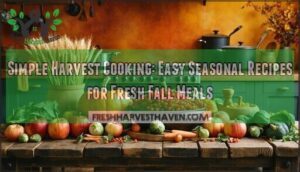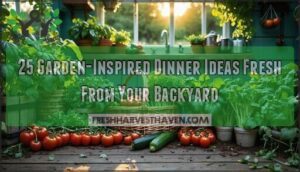This site is supported by our readers. We may earn a commission, at no cost to you, if you purchase through links.
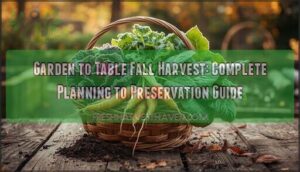
Cool-season crops actually thrive when temperatures drop, developing deeper flavors and sweeter profiles than their summer counterparts. The secret isn’t luck or a magical green thumb. It’s understanding how to work with autumn’s rhythms instead of against them.
From calculating precise planting dates to protecting crops during cold snaps, a successful garden-to-table fall harvest requires different strategies than spring and summer growing. Master these techniques, and you’ll transform those shorter days into one of your most productive and flavorful harvests of the year.
Table Of Contents
Key Takeaways
- Time your fall plantings by counting backward from your first frost date and adding 10–14 days to the seed packet’s maturity time, then adjust for your specific zone—northern gardeners start in early July while southern zones can wait until September.
- Cool-weather crops like kale, carrots, and Brussels sprouts develop sweeter, deeper flavors after frost exposure, making autumn harvests more flavorful than their summer counterparts when you match each crop to its light and soil needs.
- Extend your harvest weeks or months beyond the first frost using row covers (adding 2–10°F warmth), cold frames (5–10°F warmer soil), or high tunnels (30–50% higher yields), combined with 2–4 inch mulch layers for root insulation.
- Preserve peak harvest flavor by freezing at 0°F within hours of picking (retains 85–90% of compounds for 18 months), while proper storage temperatures—32–40°F for roots with high humidity, 50–55°F for peppers—can extend shelf life by up to 50%.
Planning Your Fall Garden to Table Harvest
Planning a fall garden starts with knowing what to plant, when to plant it, and how to set up your space for success. You’ll need to think about your local climate, pick the right crops, and prepare your soil before the growing season begins.
These four key areas will help you build a productive fall garden that brings fresh vegetables to your table through autumn and beyond.
Selecting Cool-Weather Vegetable Crops
When choosing cool-weather crops, you’re building the backbone of your fall vegetable garden. Start with varieties that offer both crop cold-hardiness and flavors that deepen after frost.
Five top-performing cool-weather crops for your fall harvest:
- Kale – Tolerates hard frosts to 25°F, matures in 56 days, delivers super-high lutein and vitamin C
- Spinach – Fast-growing leafy greens ready in 45 days with excellent nutritional profiles
- Carrots – Medium maturity timeframes (70–80 days), sweet flavor improves with light frost
- Brussels sprouts – Long-season brassicas needing 120 days but worth the space requirements
- Collard greens – Disease resistance champions yielding 8–10 tons per acre with minimal fuss
Select vegetable varieties based on your harvest timeline and available garden space. You can also use row covers or cold frames to protect plants from early frosts.
Understanding Planting Zones and Frost Dates
Your planting schedule hinges on knowing your USDA hardiness zone and local frost dates. The 2023 USDA map shows zone hardiness shifts northward due to warming trends, with growing seasons now extending roughly two weeks longer than a century ago.
First fall frost timing varies widely—Zone 5 sees frost between October 13–21, while Zone 8 waits until November 7–28. Count backward from your area’s average first frost date, add extra days for slower fall growth, and factor in microclimate considerations like low-lying frost pockets that freeze earlier than surrounding areas.
The updated map, jointly developed by USDA’s Agricultural Research Service and Oregon State University’s PRISM Climate Group, is available as an interactive GIS.
| Zone | First Fall Frost | Planting Window |
|---|---|---|
| Zone 5 | Oct 13–21 | Early July |
| Zone 6 | Oct 20–28 | Mid-July |
| Zone 7 | Oct 28–Nov 7 | Late July–Early Aug |
| Zone 8 | Nov 7–28 | Mid–Late August |
| Zone 9 | Nov 15–Dec 15 | September |
Preparing Soil for Autumn Planting
Once you know your frost dates, turn your attention to garden soil. Test soil pH—most vegetables prefer 6.0 to 7.2—and check nutrient levels through a local lab.
Apply organic amendments like compost or manure in fall, giving them months to feed the soil and improve structure. Cover crops such as oats boost nitrogen and prevent erosion, while tilling 4–6 inches deep helps prepare your site for planting.
Garden Layout and Succession Planting Strategies
Your fall vegetable garden thrives when you design with intention. Raised beds oriented north–south capture maximum sunlight, while narrow borders between 1.5 and 2.5 feet wide fit along fences and pathways, boosting productive space by 30%.
Plant in zigzag patterns to increase density by 20%, and rotate crops by family every few seasons to cut pests and build soil health.
Succession planting every two to four weeks keeps harvests steady, extending your garden-to-table rhythm well into autumn.
When to Plant Fall Harvest Vegetables
Timing your fall plantings right means working backward from your first frost date, which acts like a deadline for getting crops to maturity. Different vegetables need different lead times, and you’ll need to account for cooler temperatures that slow things down as autumn arrives.
Here’s what you need to know to calculate when each crop should go in the ground.
Calculating Planting Dates by Crop
You don’t need to guess at planting dates when you’ve got frost date math and a calculator tool to guide you. Start by finding your average first frost date through regional calendars, then count backward using each crop’s days to maturity plus a 10–14 day buffer for cooler fall conditions.
Here’s your simple vegetable garden planning formula:
- Look up your local frost date using extension resources or planting date calculators
- Add 10–14 days to the seed packet’s listed days to maturity
- Count that total backward from your frost date to find your planting window
- Adjust for microclimate differences if your garden’s warmer or cooler than average
This approach works beautifully for cool-weather crops and ensures your fall harvest matures before hard frost arrives.
Timing for Leafy Greens, Roots, and Brassicas
Each crop type has its own sweet spot for fall planting, and you’ll want to match your schedule to their unique needs. Leafy greens like spinach and lettuce need 8–10 weeks before frost, while root crops demand mid-August starts, and brassicas like broccoli require a full 10–12 weeks to reach harvest size.
| Crop Category | Planting Window | Days to Maturity |
|---|---|---|
| Leafy Greens | Mid-August to mid-September | 40–70 days |
| Root Crops | August 1–September 1 | 50–75 days |
| Brassicas | August 1–September 1 | 70–100 days |
Regional schedules shift these planting windows based on zone—Southern gardeners can wait until late August, while Northern growers start in early July. Brassica planting and cabbage family crops gain sweetness after frost, making frost tolerance a bonus rather than a worry for your fall vegetable garden.
Direct Sowing Vs. Transplanting in Fall
When choosing between direct seed and transplants for your fall harvest, you’ll want to weigh speed against simplicity. Transplanting vegetable seedlings lets you start indoors and skip cold soil temperature delays, pushing harvest timing 10–14 days earlier for leafy greens—but direct sowing vegetables cuts labor costs and builds stronger root development from day one.
- Root crops (carrots, beets, radishes) need direct seeding to avoid transplant damage
- Leafy greens and brassicas benefit from transplants, gaining frost resilience and faster canopy growth
- Direct-sown plants show 10–15% better drought tolerance due to uninterrupted roots
- Transplants face less pest exposure during emergence, reducing slug damage by up to 18%
Adjusting for Regional Climate Differences
Your garden doesn’t live in Zone 7 if it’s tucked behind a windbreak in Zone 5, so you’ll need to track your microclimate alongside official first frost dates.
Zone-Specific Planting means northern gardeners (Zones 3–5) sow cool-weather crops by early July, while southern zones plant fall harvest greens into September.
Soil Temperature Influence and Frost Date Impact drive planting dates more than the calendar alone—add two weeks for cooler fall conditions and use season extension tools like row covers for reliable frost protection.
Growing and Caring for Fall Crops
Once your fall crops are in the ground, they need the right conditions to thrive through cooler weather. Each vegetable has specific needs for light, soil, water, and protection that will determine how well it produces.
Here’s what you need to know to keep your autumn garden healthy and productive through harvest time.
Sunlight and Soil Requirements by Vegetable
Your fall vegetable garden thrives when you match each plant to its light requirements and soil type. Leafy greens like lettuce and spinach tolerate partial shade with 4–6 hours of sun, while carrots and radishes need full sun exposure—at least 6 hours daily—to develop strong roots.
- Test your soil pH before planting; most vegetable varieties prefer 6.0–7.5, though brassicas like broccoli lean toward neutral conditions.
- Mix in 2–3 inches of organic matter annually to boost nutrient retention by up to 30%.
- Group plants by sun exposure to reduce competition and get the most out of space.
- Keep clay content below 35% for proper root oxygen flow.
- Use management strategies like raised beds to warm soil 5–8°F, extending your season under temperature influence.
Watering and Fertilizing in Cooler Weather
When temperatures drop, your watering strategy needs to shift gears—most fall crops still need about 1 inch weekly, but you’ll water less often and focus on timing. Early morning irrigation cuts evaporation and disease risk, while deep watering once or twice weekly pushes roots down for better resilience at harvest time.
Root crops like carrots and beets love phosphorus-rich soil for flavor enhancement, while leafy greens want slightly more nitrogen. Light fertilization in early fall aids active growth before dormancy, and drip fertigation ensures even delivery without waste—you’ll conserve up to 50% water while harvesting vegetables in fall at peak sweetness.
| Task | Fall Method |
|---|---|
| Irrigation Timing | Water early morning to minimize fungal issues and evaporation loss |
| Frequency | Deep watering 1–2 times weekly maintains root temperature stability |
| Mulch Moisture | Apply 2–3 inch layer to insulate roots and retain soil moisture |
| Cool-Season Nutrients | Use balanced organic blends (7-7-7) for steady growth without burn |
| Fertigation Strategies | Pair drip systems with liquid feeds to prevent leaching during rain |
Protecting Crops From Frost and Pests
Once you’ve dialed in your watering and nutrients, you’ll want to shield your plants from the twin threats every fall gardener faces—sudden cold snaps and hungry pests. Frost mitigation starts with knowing your first frost date and using row covers or overhead irrigation (2.5–5 mm/hour) to raise temperatures by up to 3°C, while IPM strategies blend biological controls and early detection to cut pest losses by 26–55%.
- Row covers and floating fabrics raise crop temperatures 3°C, protecting fall and winter crops during cold nights
- Overhead irrigation releases heat as water freezes, maintaining surface temperatures near 0°C for crop protection
- Biological controls (parasitoids, predators) suppress pest populations 40–85%, reducing chemical reliance
- Pheromone traps and visual lures catch outbreaks early, cutting severity by 60% through timely pest management
- Mulch layers (2–4 inches) insulate roots from frost while disrupting pest life cycles for disease prevention
Extending The Harvest With Season Extension Techniques
Beyond frost shields and pest barriers, you can stretch your harvest weeks or even months longer with smart season extension techniques. Row cover benefits include 2–10°F warmer nighttime air, while tunnel microclimates add another 4°F of warmth to uncovered beds, protecting fall and winter crops well into December.
High tunnel yields jump 30–50% compared to open fields, and cold frame crops like spinach and lettuce thrive in soil that stays 5–10°F warmer.
Mulch soil with organic layers to lock in moisture and insulate roots, turning your garden into a year-round farm-to-table treasure.
Harvesting and Storing Fall Produce
Knowing when and how to harvest makes all the difference between produce that shines on your table and crops that lose their flavor in storage. The right timing protects the work you’ve put into your fall garden, while proper handling keeps your vegetables fresh for weeks or even months.
Let’s walk through what to look for when your crops are ready, how to harvest without damage, and the smartest ways to store what you’ve grown.
Signs of Maturity for Popular Fall Vegetables
Knowing when your fall vegetables reach their prime can feel like reading nature’s subtle cues, but a few reliable signs make harvesting fall vegetables straightforward. Check these maturity time indicators to bring your best produce from garden to table:
- Carrots: Look for carrot shoulder size around ¾ inch in diameter showing at soil level, with tops reaching 10–12 inches tall after 60–80 days.
- Beetroot: Harvest when beetroot diameter measures 1–3 inches, usually 55–70 days after planting, before woody texture develops.
- Broccoli: Watch for broccoli floret tightness—heads should be full and compact without yellowing, ready 70–100 days post-transplanting.
- Pumpkin: Test pumpkin rind hardness with your thumbnail; mature rinds resist pressure and lose their gloss after 90–120 days.
- Leafy greens: Harvest before leafy green bolting occurs when temperatures climb or leaves yellow, usually 45–55 days for best sweetness.
Best Practices for Harvesting Root and Leafy Crops
Once you know your crops are ready, how you harvest them makes all the difference in what lands on your plate. Harvest early morning when it’s cooler than 70°F; this keeps greens crisp and slows wilting. Water the day before harvest time if soil feels compact, then trim foliage to half an inch above root tops to prevent decay.
Use a garden fork to loosen soil three to five inches from roots—this prevents breakage and keeps carrots, beets, and parsnips intact. For leafy crops like kale and collards, pick two to three outer leaves while leaving five to six younger ones to keep growing.
Rinse harvested vegetables gently, air-dry in shade for one to two hours, then cool them quickly to preserve that just-picked flavor.
| Crop Type | Harvesting Techniques | Best Timing |
|---|---|---|
| Root crops | Loosen soil with fork 3–5 inches away; trim tops to 0.5–1 inch | Moderate soil moisture; day after watering |
| Leafy crops | Remove 2–3 outer leaves; use sharp shears to cut at base | Early morning below 70°F |
| Brassicas | Cut heads with sharp knife; leave stem for side shoots | When heads are compact and tight |
Short-Term Storage and Handling Tips
Right after harvest, get your vegetables into cool storage fast. Removing field heat within hours can stretch shelf life by up to 50%.
Refrigeration works for most crops, but temperature matters. Root vegetables like carrots and beets need 32–40°F with high humidity, while tomatoes and peppers store best around 50–55°F to avoid damage.
Use mesh bags or perforated packaging options for airflow management, preventing condensation that invites rot. Keep ethylene-producing crops like tomatoes away from sensitive greens, since ethylene gas speeds ripening and cuts shelf life short.
Managing Common Harvest and Storage Challenges
Even with careful handling, you’ll face garden harvest challenges like post-harvest decay and wilting. Temperature management is your first defense—storing cabbage at 32°F with high humidity prevents rot, while onions need warm, dry conditions.
Moisture control matters too; excess humidity above 95% invites mold on squash. Watch for ethylene sensitivity by keeping tomatoes away from leafy greens, since gas exposure causes yellowing within days.
Modern technologies like automated climate controls reduce losses by 30–50%, making vegetable storage techniques more reliable than ever.
Preserving and Enjoying Your Fall Harvest
Your fall harvest doesn’t end when you pull the last carrot from the ground. The real magic happens when you transform those fresh vegetables into preserved foods that carry their flavor through winter and onto your table.
Here’s how to make the most of everything you’ve grown, from freezer bags to fermentation crocks to simple weeknight dinners.
Freezing, Canning, and Fermenting Techniques
Once your fall crops come in, you can lock in that harvest-day quality through three reliable methods: freezing, canning, and fermenting.
Freezing works fast and keeps nutrients intact—blanch your greens and roots first, then freeze at 0°F to preserve flavor for up to 18 months.
Canning offers shelf-stable storage without electricity, though pressure canning is essential for low-acid vegetables like beans.
Fermentation transforms your produce into probiotic-rich foods while boosting certain vitamins and requiring almost no energy at all.
Recipes for Garden-to-Table Fall Meals
Your fall harvest isn’t just ingredients—it’s the start of meals that can transform your table. Root Vegetable Roasts highlight the natural sweetness in carrots and beets, while Fall Soup Recipes convert leeks and potatoes into comfort food. Kale Salad Variations and Brussels Sprouts Dishes showcase cruciferous vegetables at their nutrient-dense peak.
Pair these homegrown veggies and fruits with Seasonal Herb Pairings like rosemary or thyme to heighten flavor through simple culinary techniques that honor your harvest.
Maximizing Flavor Through Preservation
Preserving methods do more than extend shelf life—they’re your best tool for flavor retention. Freezing at −18 °C locks in 85–90% of natural flavor compounds, while gentle processing techniques like vacuum dehydration maintain up to 88% of flavor esters.
Freezing at −18 °C locks in 85–90% of natural flavor compounds, making it your strongest tool for preserving harvest-day taste through winter
Temperature impact matters: store at 4 °C to keep aromatic intensity strong. Natural additives such as rosemary or thyme essential oils delay oxidation and preserve terpenes better than synthetic options.
Advanced packaging with oxygen barriers and controlled environments cut volatile compound loss by 45–60%, turning your harvest into culinary techniques that deliver peak taste months later.
Safe Home Food Storage Methods
Your fridge needs to sit at 40°F or below, and your freezer at 0°F to keep bacteria at bay. Ground meats and seafood last just 1–2 days refrigerated, while most vegetables hold their quality for 10–12 months frozen. Home-canned goods stay safe for a year when stored between 40°F and 70°F in dark, cool spots.
Use the FIFO Method—first in, first out—to rotate your pantry and prevent waste, ensuring your preserved harvest delivers peak flavor and food safety.
Frequently Asked Questions (FAQs)
How do fall crops impact soil health?
Cover crops can boost soil organic carbon by around 6% down to 70 cm depth, enhancing nutrient availability.
Your fall harvest aids nutrient cycling, improves soil structure, increases microbial activity, builds organic matter, and provides natural pest control through cover crop benefits.
Can you grow fall vegetables in containers?
You can absolutely grow fall vegetables in containers, and it’s one of the best ways to extend your home garden harvest into cooler months.
Container gardening works beautifully for fall vegetables like lettuce, spinach, kale, radishes, and carrots.
What companion plants work best in fall?
Companion planting in your fall vegetable garden works like a protective partnership. Alliums—garlic, onions, leeks—repel aphids and cabbage worms by about 50-70%, while marigolds and nasturtiums attract beneficial insects that control pests naturally.
These plants enhance soil health and boost growth promotion for brassicas and leafy greens through improved pest deterrence.
How do you save seeds from fall?
You’ll want to collect seeds when they’re hard and the heads have browned, which shows they’re mature.
After harvesting, clean them through fermentation for fleshy fruits or dry processing for grains, then store in cool, dark conditions below 40% humidity to keep them viable for years.
Which fall crops regrow after first harvest?
Ever wonder which crops keep giving after you pick them? Leafy greens like kale and spinach regrow in one to three weeks, offering multiple harvests throughout fall.
Root crops such as beets produce fresh greens when you leave roots intact.
Conclusion
Your grandmother knew this secret without reading a single guide—fall’s harvest doesn’t end when summer crops fade. Now you’ve got the full playbook: from counting back frost dates to transforming baskets of kale into preserved meals that taste like October in January.
Each garden to table fall harvest you complete builds skills that compound year after year. The beds you mulch tonight, the succession plantings you schedule, the first bite of frost-sweetened carrots—they’re all investments in becoming the gardener who harvests while others wait for spring.

